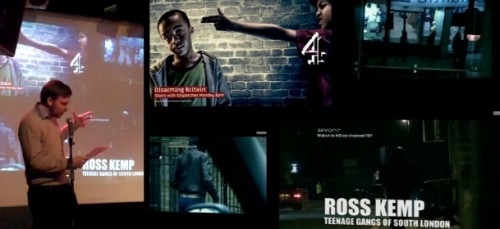London filmmaker Michael Story sent in a short video he made about the mismatch between crime as presented in TV reports and the reality of crime in the UK. TV reports, Michael argues, misrepresent how common crime is, where it occurs, and who is most likely to be involved in violent crime; in so doing, they reinforce stereotypes about race, ethnicity, class, and criminality:
London’s 66,000 guns – by Michael Story from chichard41 on Vimeo.


Comments 66
Yrro Simyarin — February 28, 2012
Always interesting when the liberal concerns of racial bias dovetails in with a conservative issue. This sort of scare-mongering has been used for years as an excuse to disarm the law abiding citizens of the UK.
London has almost no gun crime. Their violent crime rate is, however, sky-high. As demonstrated by the riots themselves, two hundred million dollars of property crime was done, 5 people killed, and 16 more injured. Personally, I doubt the victims particularly care whether this damage was done with a gun or not. While their gun crime rate is incredibly low, London's violent crime rate is 7 times that of New York City.
And despite that, the media examples here all talk about how easy it is to get guns - not about how easy it is to beat up another youth and take their wallet. Despite that being one of the most common crimes in the city.
Gilbert Pinfold — February 28, 2012
In the US, though, gangsta culture seems to represent itself scarily without any help from The Man.
http://www.worldstarhiphop.com/videos/
Anonymous — February 28, 2012
I like what he said about "violent criminals tend to go after those like themselves." I have no idea about Britain, but if the media is anything like the US, they try to instill fear of certain groups in the populations least like the feared groups. Old or middle aged women (of any race) are often the targets of media trying to say "roving gangs of teenagers, particularly boys, are a danger." The group most targeted for "warnings" about urban black and Hispanic adult men are young white women and girls, especially those who live in suburban areas. Now, sure, occasionally gangs of teenagers will terrorize an old woman, aure, a few white women and girls have been kidnapped from their suburban homes or assaulted by black and Hispanic men, but in the grand scheme of things, this is rare. In comparison, you rarely see media coverage of kidnappings of nonwhite girls and women, or teenage gang violence towards other teenage gangsters (again, not unheard of, but if you;d believe the media, it's not very common), at least not to the extent that you see the opposite. There's some "warning" against, say, suburban white men aimed towards suburban white women and girls, but there is no conditioned inherent fear of strange white men, despite the likes of Ted Bundy. There's very little "warning" aimed at men at all, despite the likes of John Wayne Gacy. It may be the presentation; it seems that no woman of any background reaches the age of 14 without her mother warning her about the Ted Bundies of the world, but they're generally presented as anomalies, and when discussed, are sick individuals. When it comes to teen gang violence, it's not "that teenager is violent, stay away from him/her," it's "all teens are suspicious and might be violent (particularly if they are nonwhite, poor, or have questionable fashion sense), stay away from all of them."
Don’t believe the hype! « Andrew Henley — February 29, 2012
[...] short video here from London film-maker Michael Story on the misrepresentation of crime in TV [...]
Ricky — February 29, 2012
My response above (or below) was too difficult to read, so I copied it here:
The ideal outcome is that the CREDIBLE threat of death or injury convinces the criminal to abort their attempted crime. Short of that, it is a better outcome for the criminal to be killed or injured than the victim
Notable Links: 3-2/12 (Early Edition) « BROTHA WOLF — March 1, 2012
[...] Misrepresenting Crime in TV Documentaries by Sociological Images [...]
Carmelin — December 17, 2025
Family entertainment often relies on channels that balance fun with age-appropriate content. Parents appreciate predictable schedules and recognizable shows that kids enjoy daily. When questions come up about programming or access, many viewers search for disney channel phone number to get official information and resolve viewing or subscription concerns.